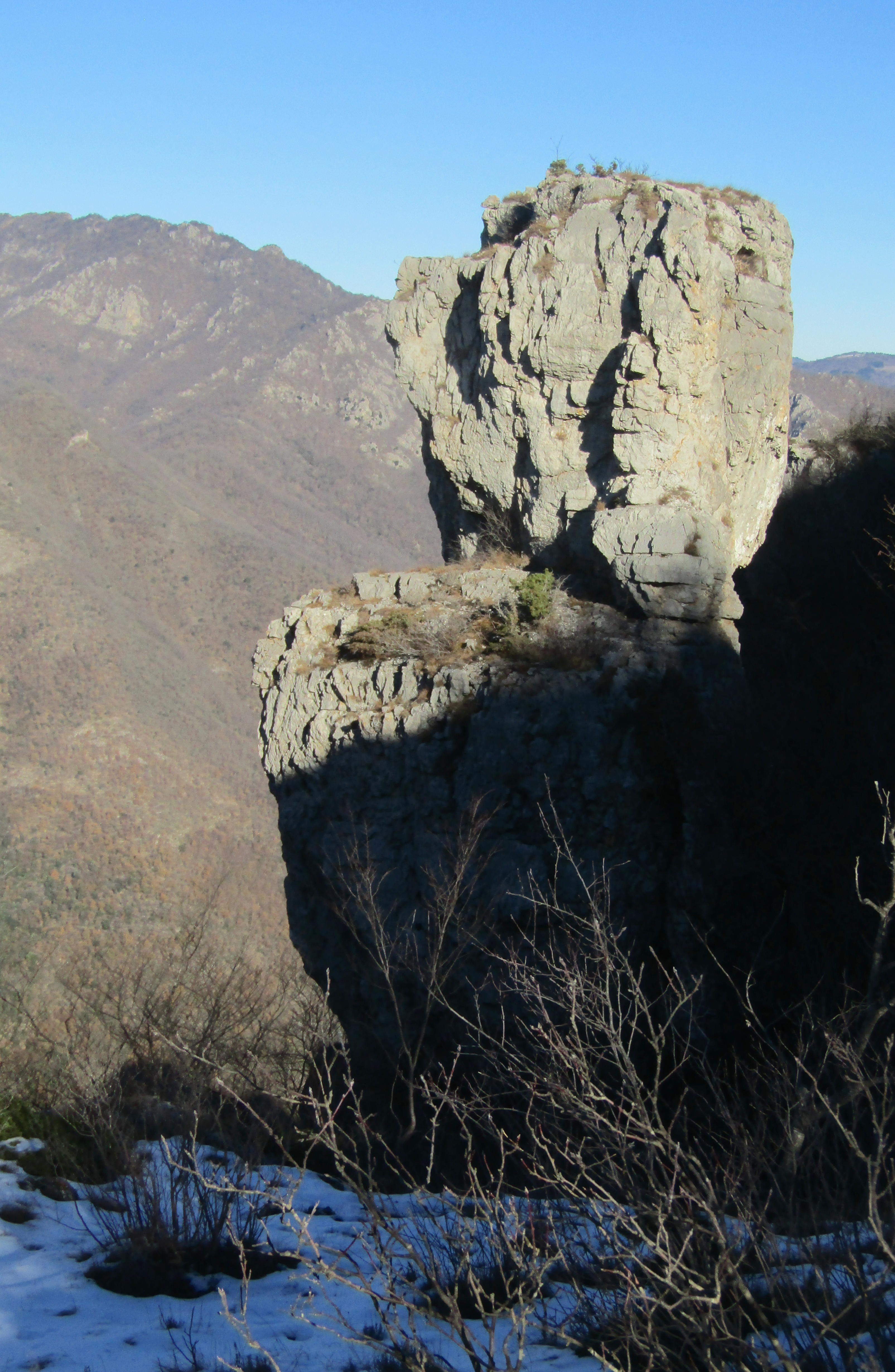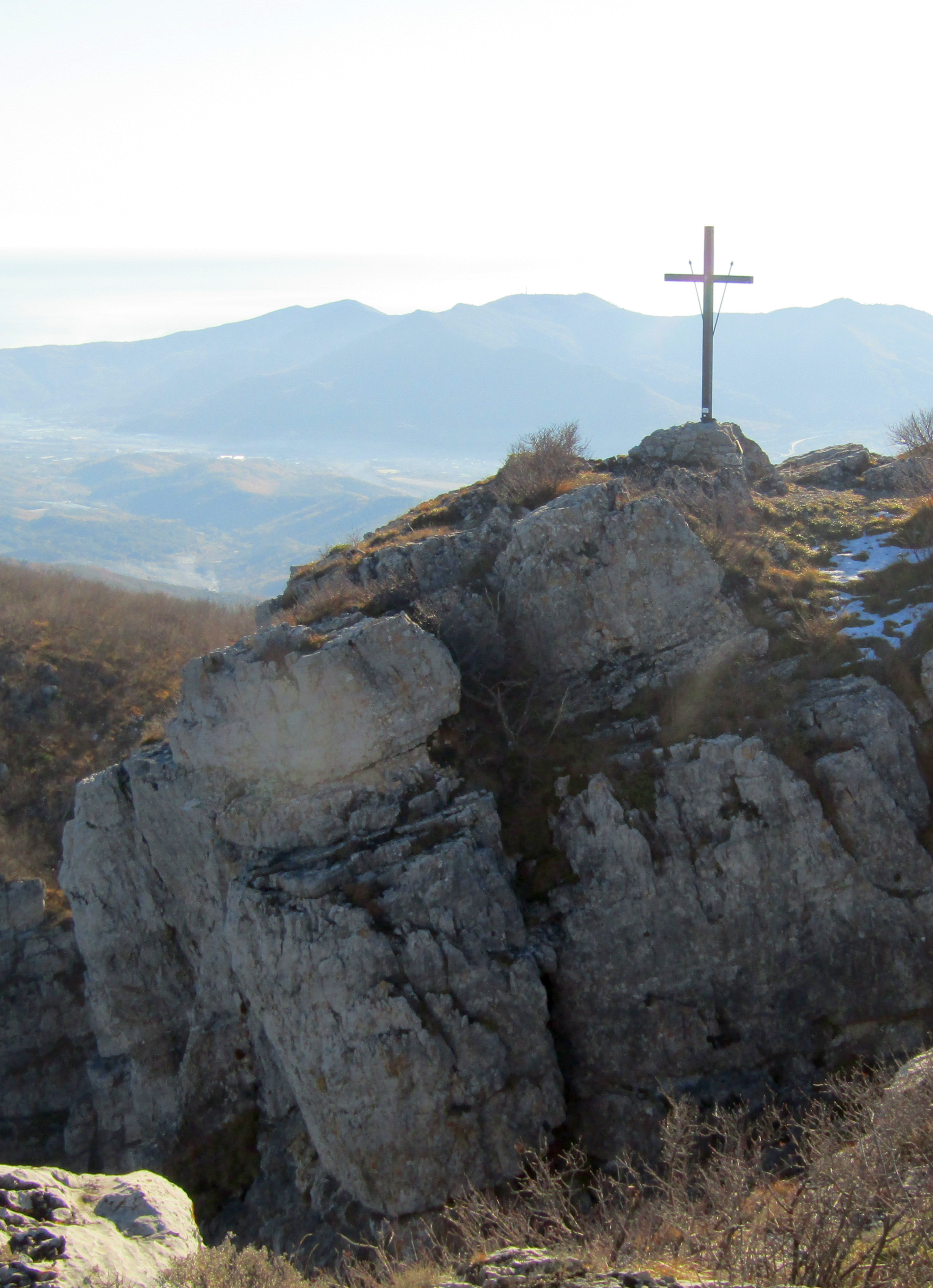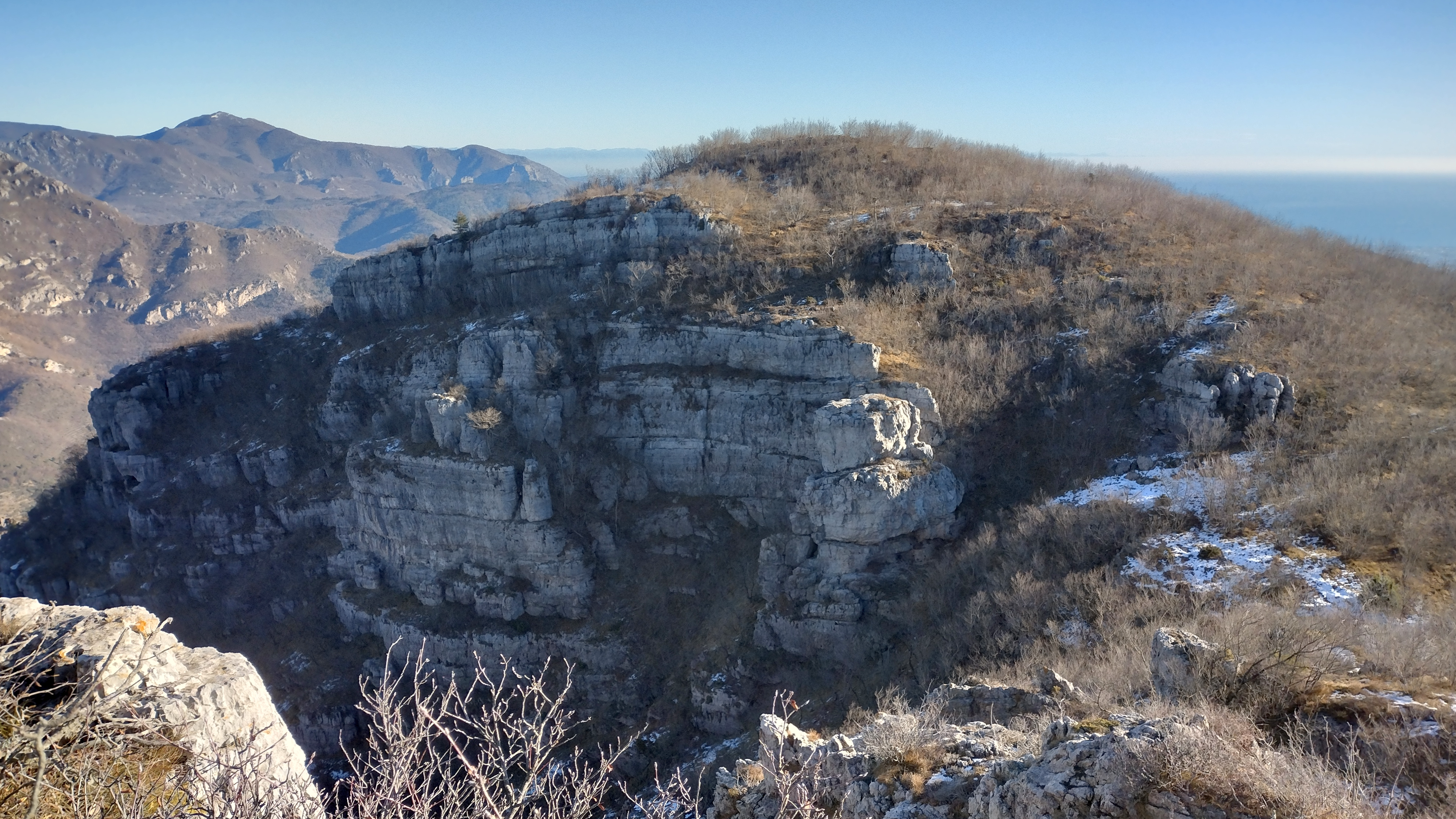Monte Peso Grande on:
[Wikipedia]
[Google]
[Amazon]
Monte Peso Grande o Castell'Ermo (1.092 m.) is a mountain of the ''

 The mountain stands on the
The mountain stands on the
www.pcn.minambiente.it
The North face of Castellermo features rock spires and sandstone cliffs. Its southern slopes also show rocky areas, but they are not so steep and are covered in thick bushes and woodland, mainly of broad-leaf trees. On the South face of the mountain also stands, in a panoramic position and at an elevation of about 1000 metres, the tiny Catholic sanctuary of ''San Calocero'', built during the Middle ages. The prominence of the mountain is 345 metres. A sub-summit East of the top of the mountain bears a cross which can be seen from the lowland. Administratively the Peso Grande belongs to the comune of Vendone; the chief town of the municipality stands in the Arroscia valley but its territory overflows the water divide and also encompasses a portion of the Pennavaira valley.
 A tectonic unit, mainly made of sandstone and dolomite, takes its name from monte Castell'Ermo. Chronologically this unit is attributed to the upper Triassic and Jurassic, while in palaeogeography it's considered as the innermost part of the Briançonnais zone, an area of the Penninic nappes of the Alps. Close to the mountain have been found characteristic radiolarites dating back to the Jurassic.
In 1904 the geologist Gaetano Rovereto, in his work ''Geomorfologia delle Valli Liguri'', mentioned the Castellermo for its ''craggy peaks, with horrid and distinctive shapes'' (''cime dirupate, orride e con forme caratteristiche'').
A tectonic unit, mainly made of sandstone and dolomite, takes its name from monte Castell'Ermo. Chronologically this unit is attributed to the upper Triassic and Jurassic, while in palaeogeography it's considered as the innermost part of the Briançonnais zone, an area of the Penninic nappes of the Alps. Close to the mountain have been found characteristic radiolarites dating back to the Jurassic.
In 1904 the geologist Gaetano Rovereto, in his work ''Geomorfologia delle Valli Liguri'', mentioned the Castellermo for its ''craggy peaks, with horrid and distinctive shapes'' (''cime dirupate, orride e con forme caratteristiche'').
 The Castell'Ermo, due to its prominent location and its strong visual impact, during prehistory was considered a kind of '' sacred mountain''. In particular on the slopes nowadays included in the municipality of Vendone, in a place referred as "Tre Pe", there was a
The Castell'Ermo, due to its prominent location and its strong visual impact, during prehistory was considered a kind of '' sacred mountain''. In particular on the slopes nowadays included in the municipality of Vendone, in a place referred as "Tre Pe", there was a


Ligurian Prealps
The Ligurian Prealps (in Italian ''Prealpi Liguri'' or ''Alpi Liguri Orientali'', in French ''Préalpes liguriennes'') are a mountain range in northwestern Italy.
They belong to the Ligurian Alps and are located between the regions of Piemonte ( ...
'', the eastern section of the Ligurian Alps.
Features

 The mountain stands on the
The mountain stands on the water divide
A drainage divide, water divide, ridgeline, watershed, water parting or height of land is elevated terrain that separates neighboring drainage basins. On rugged land, the divide lies along topographical ridges, and may be in the form of a singl ...
between Arroscia (South) and Pennavaira valleys. Westwards a saddle named ''Colla d'Onzo'' divides it from the minor elevations of ''Prati di Bacelega'' and ''Monte Cucco'', while eastwards the ridge goes on with the E summit of Castellermo (1.062 m), goes down to the Colla di Curenna (900 m about), rises up to the Monte Nero (981 m) and ends in the lowland of Albenga.Italian official map 1:25.00 of '' Istituto Geografico Militare'' (on-line owww.pcn.minambiente.it
The North face of Castellermo features rock spires and sandstone cliffs. Its southern slopes also show rocky areas, but they are not so steep and are covered in thick bushes and woodland, mainly of broad-leaf trees. On the South face of the mountain also stands, in a panoramic position and at an elevation of about 1000 metres, the tiny Catholic sanctuary of ''San Calocero'', built during the Middle ages. The prominence of the mountain is 345 metres. A sub-summit East of the top of the mountain bears a cross which can be seen from the lowland. Administratively the Peso Grande belongs to the comune of Vendone; the chief town of the municipality stands in the Arroscia valley but its territory overflows the water divide and also encompasses a portion of the Pennavaira valley.
SOIUSA classification
According to the SOIUSA (''International Standardized Mountain Subdivision of the Alps'') the mountain can be classified in the following way:. * main part = Western Alps; major sector = South Western Alps, section = Ligurian Alps, subsection = Prealpi Liguri * supergroup = Catena Settepani-Carmo-Armetta, group = Gruppo Galero-Armetta, subgroup = Dorsale della Rocca delle Penne,code
In communications and information processing, code is a system of rules to convert information—such as a letter, word, sound, image, or gesture—into another form, sometimes shortened or secret, for communication through a communication ...
= I/A-1.I-A.3.c
Geology
 A tectonic unit, mainly made of sandstone and dolomite, takes its name from monte Castell'Ermo. Chronologically this unit is attributed to the upper Triassic and Jurassic, while in palaeogeography it's considered as the innermost part of the Briançonnais zone, an area of the Penninic nappes of the Alps. Close to the mountain have been found characteristic radiolarites dating back to the Jurassic.
In 1904 the geologist Gaetano Rovereto, in his work ''Geomorfologia delle Valli Liguri'', mentioned the Castellermo for its ''craggy peaks, with horrid and distinctive shapes'' (''cime dirupate, orride e con forme caratteristiche'').
A tectonic unit, mainly made of sandstone and dolomite, takes its name from monte Castell'Ermo. Chronologically this unit is attributed to the upper Triassic and Jurassic, while in palaeogeography it's considered as the innermost part of the Briançonnais zone, an area of the Penninic nappes of the Alps. Close to the mountain have been found characteristic radiolarites dating back to the Jurassic.
In 1904 the geologist Gaetano Rovereto, in his work ''Geomorfologia delle Valli Liguri'', mentioned the Castellermo for its ''craggy peaks, with horrid and distinctive shapes'' (''cime dirupate, orride e con forme caratteristiche'').
History
 The Castell'Ermo, due to its prominent location and its strong visual impact, during prehistory was considered a kind of '' sacred mountain''. In particular on the slopes nowadays included in the municipality of Vendone, in a place referred as "Tre Pe", there was a
The Castell'Ermo, due to its prominent location and its strong visual impact, during prehistory was considered a kind of '' sacred mountain''. In particular on the slopes nowadays included in the municipality of Vendone, in a place referred as "Tre Pe", there was a dolmen
A dolmen () or portal tomb is a type of single-chamber megalithic tomb, usually consisting of two or more upright megaliths supporting a large flat horizontal capstone or "table". Most date from the early Neolithic (40003000 BCE) and were somet ...
presumably built by the Ligures, which unfortunately was destroyed by some youngsters of the village in the early post war
In Western usage, the phrase post-war era (or postwar era) usually refers to the time since the end of World War II. More broadly, a post-war period (or postwar period) is the interval immediately following the end of a war. A post-war period c ...
years.
The sacredness of the place was also recognized during the Middle ages, when was built the Sanctuary of San Calocero, which nowadays remains the destination of a pilgrimage, taking place every five years and involving many worshipers coming from the nearby villages. The same name ''Castellermo'', a short form of ''Castello dell'Eremo'' (in English ''Castle of the hermitage''), is connected to an ancient tradition stating that saint Calocerus lived there as an hermit.
During the years of the Resistance
Resistance may refer to:
Arts, entertainment, and media Comics
* Either of two similarly named but otherwise unrelated comic book series, both published by Wildstorm:
** ''Resistance'' (comics), based on the video game of the same title
** ''T ...
the area was used as a refuge by the '' partigiani''. In the ''Casone dei Crovi'', an old building close tho the summit of mount Peso Grande, at the end of 1943 some partisans led by commander Felice Cascione composed the famous song ''Fischia il vento
"Fischia il vento" is an Italian popular song whose text was written in late 1943, at the inception of the Resistenza. Along with '' Bella ciao'' it is one of the most famous songs celebrating the Italian resistance.
History
The song was broadc ...
'', which was executed in public for the first time in the nearby village of Curenna.
Access to the summit


Hiking
The Castellermo can be reached from San Calocero sanctuary, which can be accessed either from the East with a footpath which runs starts from Arnasco and runs close to the Arroscia/Pennavaira ridge, or from West, also following the water divide. San Calocero can also be accessed by some villages in the comune of Vendone like Borgo di Curenna. These itineraries aren't difficult and doesn't require alpinistic skills. The round-shaped Eastern sub-summit of the Castellermo can be accessed offtrack starting from the saddle on the Arroscia/Pennavaira ridge which divides it from the main summit. The hike can be nice even in winter, due to the mild climate of the area, but is not advisable during the summer, when the heat can be excessive.Rock climbing
Although the rock is not considered of a good quality, on the North face of the mountain have been described several climbing routes. The climbers' frequentation was forbidden in the lateXX century
The 20th (twentieth) century began on
January 1, 1901 ( MCMI), and ended on December 31, 2000 ( MM). The 20th century was dominated by significant events that defined the modern era: Spanish flu pandemic, World War I and World War II, nuclear ...
due to the annoyance that it caused to the nesting birds of the area.Some of these routes have been experimentally re-opened because the experts assessed they had a minor impact on the wildife.
Environment protection
The mountain and its surrounding area are included in the SCI ''( Site of Community Importance)'' named ''Castell'Ermo - Peso Grande'' (code: IT1324818).References
Bibliography
* *Maps
* * {{DEFAULTSORT:Peso Grande monte One-thousanders of Italy Mountains of Liguria Mountains of the Ligurian Alps Province of Savona